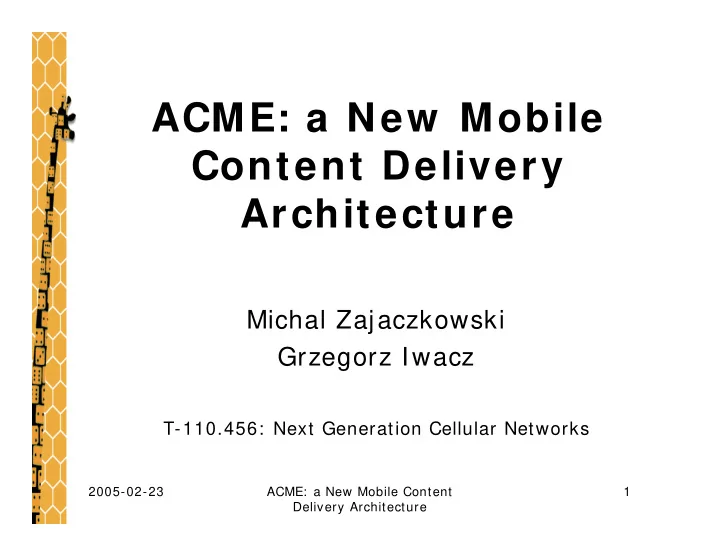

ACME: a New Mobile Content Delivery Architecture Michal Zajaczkowski Grzegorz Iwacz T-110.456: Next Generation Cellular Networks 2005-02-23 ACME: a New Mobile Content 1 Delivery Architecture
Agenda: � Introduction � Revision of wireline content delivery techniques � Bottlenecks in wireline and wireless networks � ACME cache � Multicast � ACME director � ACME Performance Analysis � ACME in CDMA Networks � Conclusions 2005-02-23 ACME: a New Mobile Content 2 Delivery Architecture
Introduction [ 1] Goals for 2.5G and 3G mobile network applications: � As close to the wireline apps as possible � Satisfactory user experience � Interactivity � Good visualization � New types of apps are available � Power efficiency 2005-02-23 ACME: a New Mobile Content 3 Delivery Architecture
Introduction [ 2] To achieve our goals we have to face a problem of latancy. It is mainly caused by: � air interface high frame corruption rate � limited bandwidth � symmetric bandwidth 2005-02-23 ACME: a New Mobile Content 4 Delivery Architecture
Introduction [ 3] A rchitecture for C ontent delivery in M obile E nvironment 2005-02-23 ACME: a New Mobile Content 5 Delivery Architecture
Revision of wireline content delivery techniques � Network Scaling � Web caching � End-System Acceleration � Content and Protocol Optimization 2005-02-23 ACME: a New Mobile Content 6 Delivery Architecture
Bottlenecks in wireline and wireless networks 2005-02-23 ACME: a New Mobile Content 7 Delivery Architecture
ACME cache 2005-02-23 ACME: a New Mobile Content 8 Delivery Architecture
multicast Caching previous browsed content is not enough! Terminals cache should have the demanded content in advance ! It is possible by m ulticasting every single response from the server, and caching it in terminal cache even if the terminal didn’t send the request. The problems are lim ited „disk” space and the battery usage in mobile devices. 2005-02-23 ACME: a New Mobile Content 9 Delivery Architecture
ACME Director [ 1] � The solution for those problems is ACME Director � 0.7-6% of size of bc groups to achieve 50% caching effectiveness � from 17 to 144 times less power consumption � better scalability! 2005-02-23 ACME: a New Mobile Content 10 Delivery Architecture
ACME Director [ 2] 2005-02-23 ACME: a New Mobile Content 11 Delivery Architecture
ACME Director [ 3] For further improvement of the bandwidth-delay- battery balance: � when network utilization increases, multicast requested content more aggressively � multicast content to active terminals only � integrate terminal battery information into multicast decision 2005-02-23 ACME: a New Mobile Content 12 Delivery Architecture
ACME Performance Analysis [ 1] Assumptions: � we analyze ACME’s performance in a slotted ALOHA system (benefits in other systems are similar) � each requested Web object is broadcast to every terminal in the cell � caches are of infinite capacity � content request and reply messages are of the same fixed size the aggregate new request rate of N terminals is λ � � collisions only in the uplink (if collision, retransmit with probability q r ) � the total offered load is G 2005-02-23 ACME: a New Mobile Content 13 Delivery Architecture
ACME Performance Analysis [ 2] � First we consider a base system with no ACME cache in use. The expected user-perceived network latency is: − G e 1 = + E 2 q r � Two key improvements ACME makes over Baseline: � Some requests can be served immediately from the ACME cache � Faster medium access due to reduced medium contention ⎛ ⎞ − G e 1 ⎜ ⎟ = + ⋅ − E 2 ( 1 h ) ⎜ ⎟ ⎝ ⎠ q r h – hit ratio of the ACME cache 2005-02-23 ACME: a New Mobile Content 14 Delivery Architecture
ACME Performance Analysis [ 3] � lightly loaded system � improvement of ACME mostly due to caching content locally � as load (probability of collision) increases � caching reduces contentions, improving latency even in the case of cache misses 2005-02-23 ACME: a New Mobile Content 15 Delivery Architecture
ACME Performance Analysis [ 4] � The slope of the curves becomes steeper as the new arrival rate increases � the medium contention reduction effect is more pronounced under heavy load 2005-02-23 ACME: a New Mobile Content 16 Delivery Architecture
ACME in CDMA Networks � ACME’s major benefit is reduced interference � „near-far” problem � the solution is the terminal power control � ACME can be thought of as a way of „ultimate” power control (transmission power reduced to zero if the content has been previously requested) 2005-02-23 ACME: a New Mobile Content 17 Delivery Architecture
Conclusions � air interface the bottleneck of mobile Web user experience � ACME extends the network edge to the terminal � ACME reduces the effect of air interface on user experience � the effectiveness of Web caching lies in user interest correlation � ACME can offer optimal balance between radio bandwidth, terminal storage and power usage 2005-02-23 ACME: a New Mobile Content 18 Delivery Architecture
References � Books: � Sudhir Dixit and Tao Wu „Content Networking In The Mobile Internet” � K. Sripanidkulchai, B. Maggs, H. Zhang „Efficient content location using interest-based locality in peer-to-peer systems”, Proc. INFOCOM 2003 � Z. Jiang and L. Kleinrock „Web prefetching in mobile environment”, IEEE Pers. Commun. (Oct. 1998) � Y. Guo and H. Chaskar „Class-based quality of service over air interfaces in 4G mobile networks”, IEEE Commun. Mag. 40(3) (2002) � Links: � http: / / www.3gpp.org/ ftp/ specs/ archive/ 23_series/ 23.846 � http: / / www.3gpp.org/ ftp/ specs/ archive/ 25_series/ 25.855 � http: / / ietf.org/ html.charters/ opes-charter.html � http: / / www.bamboomc.com 2005-02-23 ACME: a New Mobile Content 19 Delivery Architecture
Recommend
More recommend